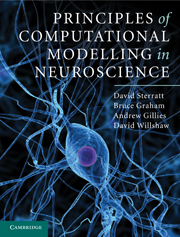Book contents
- Frontmatter
- Contents
- List of abbreviations
- Preface
- Acknowledgements
- Chapter 1 Introduction
- Chapter 2 The basis of electrical activity in the neuron
- Chapter 3 The Hodgkin–Huxley model of the action potential
- Chapter 4 Compartmental models
- Chapter 5 Models of active ion channels
- Chapter 6 Intracellular mechanisms
- Chapter 7 The synapse
- Chapter 8 Simplified models of neurons
- Chapter 9 Networks of neurons
- Chapter 10 The development of the nervous system
- Chapter 11 Farewell
- Appendix A Resources
- Appendix B Mathematical methods
- References
- Index
Chapter 6 - Intracellular mechanisms
Published online by Cambridge University Press: 05 June 2012
- Frontmatter
- Contents
- List of abbreviations
- Preface
- Acknowledgements
- Chapter 1 Introduction
- Chapter 2 The basis of electrical activity in the neuron
- Chapter 3 The Hodgkin–Huxley model of the action potential
- Chapter 4 Compartmental models
- Chapter 5 Models of active ion channels
- Chapter 6 Intracellular mechanisms
- Chapter 7 The synapse
- Chapter 8 Simplified models of neurons
- Chapter 9 Networks of neurons
- Chapter 10 The development of the nervous system
- Chapter 11 Farewell
- Appendix A Resources
- Appendix B Mathematical methods
- References
- Index
Summary
Intracellular ionic signalling plays a crucial role in channel dynamics and, ultimately, in the behaviour of the whole cell. In this chapter we investigate ways of modelling intracellular signalling systems. We focus on calcium, as it plays an extensive role in many cell functions. Included are models of intracellular buffering systems, ionic pumps, and calcium dependent processes. This leads us to outline other intracellular signalling pathways involving more complex enzymatic reactions and cascades. We introduce the well-mixed approach to modelling these pathways and explore its limitations. When small numbers of molecules are involved, stochastic approaches are necessary. Movement of molecules through diffusion must be considered in spatially inhomogeneous systems.
Ionic concentrations and electrical response
Most work in computational neuroscience involves the construction and application of computational models for the electrical response of neurons in experimental and behavioural conditions. So far, we have presented the fundamental components and techniques of such models. Already we have seen that differences in particular ionic concentrations between the inside and outside of a cell are the basis of the electrical response. For many purposes our electrical models do not require knowledge of precise ionic concentrations. They appear only implicitly in the equilibrium potentials of ionic species such as sodium and potassium, calculated from the Nernst equation assuming fixed intra-and extracellular concentrations (Chapter 2). The relative ionic concentrations, and hence the equilibrium potentials, are assumed to remain constant during the course of the electrical activity our models seek to reproduce.
- Type
- Chapter
- Information
- Principles of Computational Modelling in Neuroscience , pp. 133 - 171Publisher: Cambridge University PressPrint publication year: 2011
- 1
- Cited by



